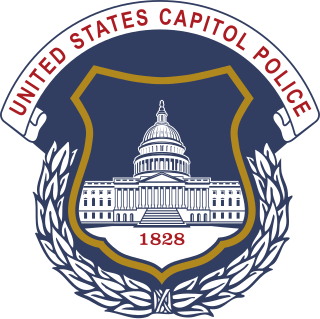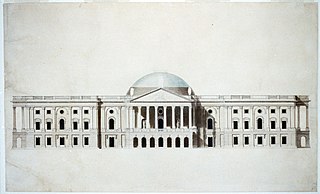In the United States, capitol attack most often refers to one of the various attacks on the United States Capitol, the meeting place of the United States Congress and the seat of the legislative branch of the U.S. federal government in Washington, D.C.

The United States Capitol, often called The Capitol or the Capitol Building, is the meeting place of the United States Congress and the seat of the legislative branch of the U.S. federal government. It is located on Capitol Hill at the eastern end of the National Mall in Washington, D.C. Though no longer at the geographic center of the federal district, the Capitol forms the origin point for the district's street-numbering system and the district's four quadrants.

The United States Capitol Police (USCP) is a federal law enforcement agency in the United States charged with protecting the United States Congress within the District of Columbia and throughout the United States and its territories. It answers to the Capitol Police Board and is the only full-service federal law enforcement agency appointed by the legislative branch of the federal government of the United States.

The 1983 U.S. Senate bombing was a bomb explosion at the United States Senate on November 7, 1983, motivated by United States military involvement in Lebanon and Grenada. The attack led to heightened security in the DC metropolitan area, and the inaccessibility of certain parts of the Senate Building. Six members of the radical far-left Resistance Conspiracy were arrested in May 1988 and charged with the bombing, as well as related bombings of Fort McNair and the Washington Navy Yard which occurred April 25, 1983, and April 20, 1984, respectively.
The 1998 United States Capitol shooting was an attack on July 24, 1998, which led to the deaths of two United States Capitol Police officers. Officer Jacob Chestnut and Detective John Gibson were killed when Russell Eugene Weston Jr. entered the Capitol and opened fire. Gibson died during surgery at MedStar Washington Hospital Center and Chestnut died at George Washington University Hospital. Weston's exact motives are unknown, but he had expressed a strong distrust of the federal government of the United States and was diagnosed with paranoid schizophrenia six years before the attack. Weston was later charged on July 26 for the murder of two U.S. Capitol Police officers during the shooting rampage. As of July 2018, Weston remained in a mental institution.
Domestic terrorism in the United States consists of incidents which are confirmed to be domestic terrorist acts. These attacks are considered domestic because they occurred within the United States and they were carried out by U.S. citizens and/or U.S. permanent residents. As of 2021, the United States government considers white supremacists to be the top domestic terrorism threat.
Right-wing terrorism, hard right terrorism, extreme right terrorism or far-right terrorism is terrorism that is motivated by a variety of different right-wing and far-right ideologies, most prominently by neo-Nazism, anti-communism, neo-fascism, ecofascism, ethnonationalism, religious nationalism, and anti-government patriot/sovereign citizen beliefs and occasionally by anti-abortionism, tax resistance and homophobia. Modern right-wing terrorism largely emerged in Western Europe in the 1970s, and following the dissolution of the Soviet Union in 1991, it emerged in Eastern Europe.

In the United States, a common definition of terrorism is the systematic or threatened use of violence in order to create a general climate of fear to intimidate a population or government and thereby effect political, religious, or ideological change. This article serves as a list and compilation of acts of terrorism, attempts of terrorism, and other such items pertaining to terrorist activities within the domestic borders of the United States by non-state actors or spies acting in the interests of or persons acting without approval of state actors.
Amine El Khalifi is a Moroccan man who was arrested by the Federal Bureau of Investigation (FBI) for plotting to carry out a suicide bombing on the United States Capitol. He was charged with "attempting to use a weapon of mass destruction against federal property" and now convicted, faces 30 years in prison.
On October 3, 2013, in Washington, D.C., Miriam Carey, a dental hygienist from Stamford, Connecticut, was shot and killed by law enforcement officers. She had attempted to drive through a White House security checkpoint in her black Infiniti G37 coupe, struck a U.S. Secret Service officer, and was chased by the Secret Service to the United States Capitol where she was shot five times in the back, including one shot which hit the left side of the back of her head. A young child, Carey's daughter, was found unharmed in the car.

The Three Percenters, also styled 3 Percenters, 3%ers and III%ers, are an American and Canadian far-right and libertarian anti-government militia.
On June 14, 2017, during a practice session for the annual Congressional Baseball Game for Charity in Alexandria, Virginia, James Hodgkinson conducted a mass shooting in which the victims shot included U.S. House Majority Whip Steve Scalise, U.S. Capitol police officer Crystal Griner, congressional aide Zack Barth, and lobbyist Matt Mika. A ten-minute shootout took place between Hodgkinson and officers from the Capitol and Alexandria Police before officers shot Hodgkinson, who died from his wounds later that day at the George Washington University Hospital. Scalise and Mika were taken to nearby hospitals where they underwent surgery.

On January 6, 2021, a mob of supporters of U.S. President Donald Trump attacked the Capitol Building in Washington, D.C., in what is commonly referred to as the Capitol attack, Capitol riot, Capitol insurrection, January 6, or 1/6. Trump's supporters sought to overturn his defeat in the 2020 presidential election by disrupting the joint session of Congress assembled to count electoral votes that would formalize the victory of President-elect Joe Biden. The Capitol Complex was locked down and lawmakers and staff were evacuated as rioters assaulted law enforcement officers, vandalized property, and occupied the building for several hours. Five people died either shortly before, during, or following the event: one was shot by Capitol Police, another died of a drug overdose, and three died of natural causes. Many people were injured, including 138 police officers. Four officers who responded to the attack died by suicide within seven months.

On January 6, 2021, Ashli Babbitt was fatally shot during the 2021 United States Capitol attack. She was part of a mob of supporters of U.S. President Donald Trump who breached the United States Capitol building seeking to overturn his defeat in the 2020 presidential election. Babbitt attempted to climb through a shattered window of a barricaded door, which led to her being shot in the shoulder/neck by a United States Capitol Police (USCP) officer. After a USCP emergency response team administered aid, Babbitt was transported to Washington Hospital Center, where she later died. The shooting was investigated and deemed to be "lawful and within Department policy". In a press release issued with the official report USCP said their officer's actions "potentially saved Members and staff from serious injury and possible death".

John Earle Sullivan, also known as Jayden X, or Activist John, is an American political activist and self-identified photojournalist who participated in the 2021 United States Capitol attack.

The following article is a broad timeline of the course of events surrounding the attack on the United States Capitol on January 6, 2021, by rioters supporting United States President Donald Trump's attempts to overturn his defeat in the 2020 presidential election. Pro-Trump rioters stormed the United States Capitol after assembling on the Ellipse of the Capitol complex for a rally headlined as the "Save America March".

The United States Capitol in Washington, D.C., became the meeting place of the United States Congress when the building was initially completed in 1800. Since that time, there have been many violent and dangerous incidents, including shootings, fistfights, bombings, poisonings and a major riot. The first significant incident was an act of war. During the War of 1812, the building was burned and severely damaged by British military forces in 1814, and then rebuilt. Other incidents were motivated by insanity, racism, fanaticism, extremism and personal grudges, and affected the Capitol building itself and sometimes other parts of the United States Capitol Complex.

On April 2, 2021, Noah Green, a 25-year-old black nationalist, killed Capitol Police officer William Evans and wounded a second officer after he deliberately rammed his car into a barricade outside the United States Capitol in Washington, D.C. As a result of the attack, the Capitol complex was locked down. Green was shot and later died at a hospital from the gunshot wounds. Green shared extremist viewpoints advanced by the Nation of Islam prior to committing his attack at the Capitol.

Law enforcement mounted a response to the 2021 United States Capitol attack, initially failing to maintain security perimeters and protect parts of the building from being breached and occupied, but succeeding at protecting members of Congress, and subsequently, as reinforcements arrived, to secure the breached Capitol.